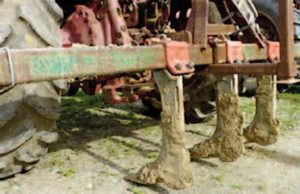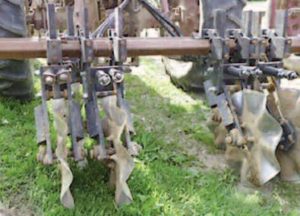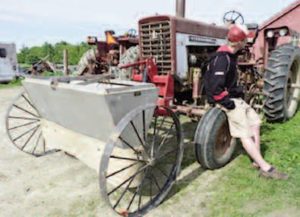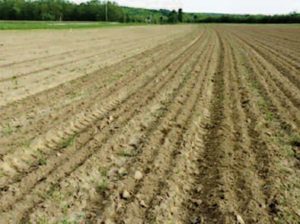By Jan Goranson and Rob Johanson, Goranson Farm, Dresden, and Jean English, Ph.D., MOFGA
Plowing and tilling soil excessively can reduce soil health by exposing soil to so much aeration that organic matter oxidizes excessively; subjecting soil to wind and water erosion; inverting soil layers, thus displacing soil organisms from their ecological niches. Plowing and tilling can also turn up weed seeds from deep in the soil profile, promoting germination.
Zone Tillage – A Possible Solution
Zone tillage, one type of reduced tillage, can help counter these effects. In zone tillage, a narrow band of soil is tilled shallowly where planting will take place, and soil between crop rows is undisturbed. For example, a planting row may be tilled a few inches wide and a few inches deep in soils without a compaction layer.
Undisturbed soil between rows may contain cover crop or green manure crop residue that protects it from erosion and moisture loss. Zone tillage combines some of the benefits of no-till production with the soil-warming benefits of tillage.This is what makes zone till a viable option for reduced tillage in the Northeast.
In soils with a plow pan or compaction layer, a subsoiler can break up soil about 2 inches below the compaction layer, and, during the same or a subsequent pass, wavy coulters and other implements can prepare a narrow zone for planting. To determine the depth of the compaction layer, a penetrometer – a metal probe that measures resistance – or a narrow metal wire can be inserted into the soil at several places in a field.
Breaking up the plow pan helps water infiltrate soils, improves soil drainage and increases crop root growth; and that deeper rooting enables plants to extract water from a greater depth of soil during droughts.
Zone tillage works well with large-seeded crops (sweet corn, vine crops, beans) and transplanted crops (tomatoes, cabbage, strawberries).




Benefits of Zone Tillage
- Growers who use zone tillage will likely save time and fuel, as less of the field is worked.
- Soil moisture- and nutrient-holding capacity can increase.
- Zone tilling in fall can prepare soils for earlier spring planting (compared with no-till or zone tilling in spring), as soils will drain and warm faster in spring.
- Even when zone tillage is done in spring, the exposed soil can warm faster – compared with no-till or a cover cropped field – as some soil is exposed to the warming sun and air temperatures of spring; so zone tillage can be better adapted to cool, northern farms than no-till.
- Zone tillage also prevents most of the soil food web from being inverted, as little soil is actually turned over.
- Zone tillage reduces the potential for soil erosion in a field, particularly when cover crop residue is left between the tilled zones.
A Maine Example
Rob Johanson and Jan Goranson own and operate their MOFGA certified organic Goranson Farm in Dresden, Maine. They started zone tilling their strawberry crop in 2007. Rob first runs a Yeomans’subsoiler shank in the row, running it between 12 and 16 inches deep, to break up the plow pan. He does this operation two years out of four. Then, in a subsequent operation, he uses wavy coulters to till a 12-inch-wide zone where he plants the crop. During this operation, he also has a drop spreader with fertilizer attached to the front of the tractor so that he can fertilize and prepare the soil for the crop in one pass.
If a heavy rain is coming, Rob will subsoil between rows so that excess water runs into the soil.
Since moving to zone tillage for all crops, Rob says they are making headway toward minimizing their weed seed bank, and their soil structure and soil biology are improving.They rototill only for small-seeded crops now (e.g.,spinach, arugula and carrots) to create a suitable seedbed, and even with this they try to till very shallowly to minimize the number of weed seeds brought to the soil surface and to maintain soil structure.
Rob notes that when he used to plow cover crops under, he’d often plow them back up again the next year, because the farm’s fine sandy loam soil lacked the living organisms to decompose the organic matter. Now, by discing cover crops only shallowly, soil structure and biology are improving.
Thanks to zone tillage, potatoes and sweet corn are now the least weedy crops at Goranson Farm; small-seeded crops are more problematic. Crop rotation helps with the latter: Goranson Farm’s four-year rotation includes two years of soilbuilding crops followed by two years of cash crops – a heavy feeder the first year (potatoes, corn, pumpkins) and a light feeder the second year (lettuce, carrots, spinach).
Rob says he can subsoil a field in 25 percent of the time required to plow it, and he does not have to disc the soil afterward,so he is saving time, labor and fuel.He uses his moldboard plow only if he is turning under sod.
Potential Problems with Zone Tillage
Potential problems related to zone tillage include
- establishment of perennial weeds over time,since the soil is cultivated less;
- difficulty planting through crop residue;
- and the expense of special tillage equipment – although growers can buy used equipment,share equipment (e.g., through www.mainefarmlandtrust.org/shared-useequipment/), and apply to the Natural Resources Conservation Service for help in offsetting the cost of some equipment.
Resources
- Reduced Tillage Fact Sheets, Fact Sheet # 1: Zone Tillage,John Idowu, Anu Rangarajan, Harold van Es and Bob Schindelbeck, Cornell Univ. https://ccesuffolk.org/assets/AG-stewardship/FactSheets/ZoneTillage-Fact-Sheet1.pdf
- Vegetable Farmers and Their Sustainable Tillage Practices, Vern Grubinger, Univ. of Vermont Extn., 2007. www.uvm.edu/vtvegandberry/Videos/tillagevideo.html (This video and others are also posted at www.youtube.com/results?search_query=vegetable+farmers +and+their+sustainable+tillage+practices&sm=3)
Publication of this fact sheet was supported by the USDA Natural Resources Conservation Service under agreement number 69- 1218-2-24.
